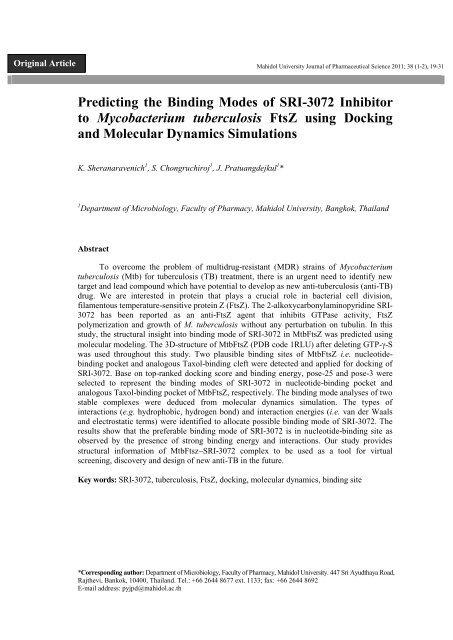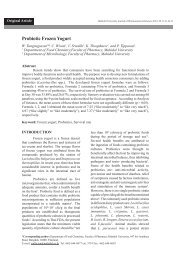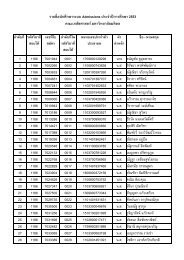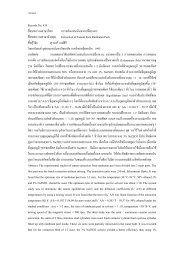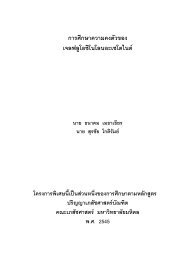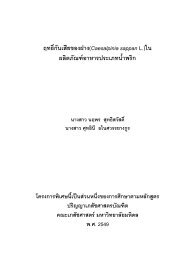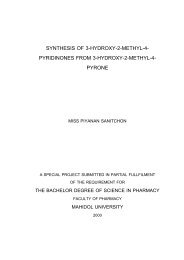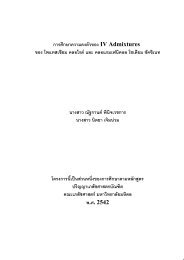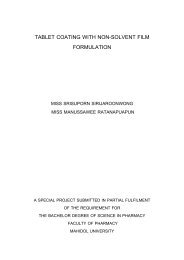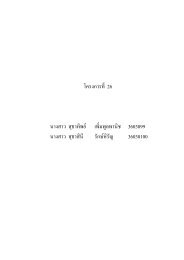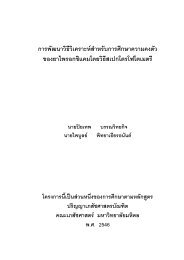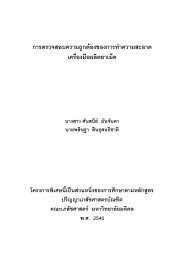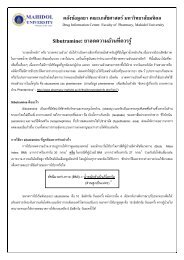Predicting the Binding Modes of SRI-3072 Inhibitor to ...
Predicting the Binding Modes of SRI-3072 Inhibitor to ...
Predicting the Binding Modes of SRI-3072 Inhibitor to ...
Create successful ePaper yourself
Turn your PDF publications into a flip-book with our unique Google optimized e-Paper software.
Original Article Mahidol University Journal <strong>of</strong> Pharmaceutical Science 2011; 38 1-2, 19-31<strong>Predicting</strong> <strong>the</strong> <strong>Binding</strong> <strong>Modes</strong> <strong>of</strong> <strong>SRI</strong>-<strong>3072</strong> <strong>Inhibi<strong>to</strong>r</strong><strong>to</strong> Mycobacterium tuberculosis FtsZ using Dockingand Molecular Dynamics SimulationsK. Sheranaravenich 1 , S. Chongruchiroj 1 , J. Pratuangdejkul 1 *1 Department <strong>of</strong> Microbiology, Faculty <strong>of</strong> Pharmacy, Mahidol University, Bangkok, ThailandAbstractTo overcome <strong>the</strong> problem <strong>of</strong> multidrug-resistant (MDR) strains <strong>of</strong> Mycobacteriumtuberculosis (Mtb) for tuberculosis (TB) treatment, <strong>the</strong>re is an urgent need <strong>to</strong> identify newtarget and lead compound which have potential <strong>to</strong> develop as new anti-tuberculosis (anti-TB)drug. We are interested in protein that plays a crucial role in bacterial cell division,filamen<strong>to</strong>us temperature-sensitive protein Z (FtsZ). The 2-alkoxycarbonylaminopyridine <strong>SRI</strong>-<strong>3072</strong> has been reported as an anti-FtsZ agent that inhibits GTPase activity, FtsZpolymerization and growth <strong>of</strong> M. tuberculosis without any perturbation on tubulin. In thisstudy, <strong>the</strong> structural insight in<strong>to</strong> binding mode <strong>of</strong> <strong>SRI</strong>-<strong>3072</strong> in MtbFtsZ was predicted usingmolecular modeling. The 3D-structure <strong>of</strong> MtbFtsZ (PDB code 1RLU) after deleting GTP--Swas used throughout this study. Two plausible binding sites <strong>of</strong> MtbFtsZ i.e. nucleotidebindingpocket and analogous Taxol-binding cleft were detected and applied for docking <strong>of</strong><strong>SRI</strong>-<strong>3072</strong>. Base on <strong>to</strong>p-ranked docking score and binding energy, pose-25 and pose-3 wereselected <strong>to</strong> represent <strong>the</strong> binding modes <strong>of</strong> <strong>SRI</strong>-<strong>3072</strong> in nucleotide-binding pocket andanalogous Taxol-binding pocket <strong>of</strong> MtbFtsZ, respectively. The binding mode analyses <strong>of</strong> twostable complexes were deduced from molecular dynamics simulation. The types <strong>of</strong>interactions (e.g. hydrophobic, hydrogen bond) and interaction energies (i.e. van der Waalsand electrostatic terms) were identified <strong>to</strong> allocate possible binding mode <strong>of</strong> <strong>SRI</strong>-<strong>3072</strong>. Theresults show that <strong>the</strong> preferable binding mode <strong>of</strong> <strong>SRI</strong>-<strong>3072</strong> is in nucleotide-binding site asobserved by <strong>the</strong> presence <strong>of</strong> strong binding energy and interactions. Our study providesstructural information <strong>of</strong> MtbFtsz<strong>SRI</strong>-<strong>3072</strong> complex <strong>to</strong> be used as a <strong>to</strong>ol for virtualscreening, discovery and design <strong>of</strong> new anti-TB in <strong>the</strong> future.Key words: <strong>SRI</strong>-<strong>3072</strong>, tuberculosis, FtsZ, docking, molecular dynamics, binding site*Corresponding author: Department <strong>of</strong> Microbiology, Faculty <strong>of</strong> Pharmacy, Mahidol University. 447 Sri Ayudthaya Road,Raj<strong>the</strong>vi, Bankok, 10400, Thailand. Tel.: +66 2644 8677 ext. 1133; fax: +66 2644 8692E-mail address: pyjpd@mahidol.ac.th
20K. Sheranaravenich et al.INTRODUCTIONTuberculosis (TB) remains <strong>the</strong>leading cause <strong>of</strong> worldwide death andcommon opportunistic infection forimmunucompromised host such as HIV/AIDS patients. Mycobacterium tuberculosis(Mtb) is a causative bacterium for TBdisease, and <strong>the</strong> number <strong>of</strong> infections hasnot declined. Poor anti-TB drug compliancehas led <strong>to</strong> <strong>the</strong> emergence <strong>of</strong> multidrugresistant(MDR) strains <strong>of</strong> Mtb. Therefore,discovery and development <strong>of</strong> anti-TBdrugs with novel mechanism <strong>of</strong> action isrequired. Filamen<strong>to</strong>us temperature-sensitiveprotein Z (FtsZ) is recently considerableas a new target for anti-bacterial drugdiscovery. FtsZ is a eukaryotic tubulinhomolog which plays an essential role inbacterial cell-division. Z-ring formation <strong>of</strong>bacterial septum can be controlled byregulating intracellular FtsZ polymerization 1-4 .FtsZ is conserved in bacteria and does notappear in human cell. Thus, FtsZ-inhibi<strong>to</strong>rscan be developed as antibacterial drugswithout any perturbation on human host cell.At present, several FtsZ inhibi<strong>to</strong>rs wereexplored <strong>to</strong> develop as potential anti-TBagents. The inhibi<strong>to</strong>rs <strong>of</strong> MtbFtsZ have beenreported so far <strong>to</strong> date, e.g. <strong>to</strong>tarol, albendazole,thiabendazole, taxanes, benzimidazoles,2-alkoxycarbonylaminopyridines and2-carbamoylpteridine 5 .In this study, we focus ourattention on compound <strong>SRI</strong>-<strong>3072</strong>, a2-alkoxycarbonylaminopyridine whichinhibits FtsZ polymerization and growth<strong>of</strong> M. tuberculosis H37Rv without anyperturbation on polymerization <strong>of</strong> bovinebrain tubulin 6-7 . The structure <strong>of</strong> <strong>SRI</strong>-<strong>3072</strong>is shown in Figure 1(a) and 1(b). <strong>SRI</strong>-<strong>3072</strong> inhibited <strong>the</strong> growth <strong>of</strong> Mtb cells atconcentration <strong>of</strong> 0.15 g/ml, inhibitedMtbFtsZ polymerization in a dose-dependentmanner with ID 50 values <strong>of</strong> 52 μM andalso inhibited <strong>the</strong> GTPase activity by20–25% at concentration <strong>of</strong> 100 μM 6 .Because <strong>SRI</strong>-<strong>3072</strong> was specific <strong>to</strong> FtsZ,thus it has potential <strong>to</strong> develop in<strong>to</strong> newanti-TB drugs effective against <strong>the</strong> currentMDR strains <strong>of</strong> M. tuberculosis. Untilnow, <strong>the</strong>re is no experimental structureavailable for give insight in<strong>to</strong> <strong>the</strong>MtbFtsZ<strong>SRI</strong>-<strong>3072</strong> interactions. In anattempt <strong>to</strong> reveal <strong>the</strong> binding mode <strong>of</strong><strong>SRI</strong>-<strong>3072</strong> with active site <strong>of</strong> FtsZ, <strong>the</strong>molecular interactions <strong>of</strong> <strong>SRI</strong>-<strong>3072</strong> withMtbFtsZ can be investigated using molecularmodeling techniques. Fortunately, <strong>the</strong> crystalstructure <strong>of</strong> MtbFtsZ in complex withcitrate, GDP and GTP--S were successfullyelucidated 8 . Structure <strong>of</strong> dimeric Mtb FtsZreveals a tight and laterally orientationwhich is differnt from <strong>the</strong> longitudinal orhead-<strong>to</strong>-tail polymer observed for αβ-tubulinand crystal structure <strong>of</strong> FtsZ obtainedfrom o<strong>the</strong>r bacterial species, e.g. Aquifexaeolicus, Bacillus subtilis, Methanococcusjannaschii, Pseudomonas aeruginosa 8-9 .The lateral association <strong>of</strong> dimeric MtbFtsZin complex with GTP--S (PDB code1RLU) is shown in Figure 1(c). There isan evidence confirms that <strong>the</strong> mutations inlateral amino are critical <strong>to</strong> proper Z-ringformation and functionality 10 . Fromavailable structure <strong>of</strong> MtbFtsZ, <strong>the</strong>interaction <strong>of</strong> <strong>SRI</strong>-<strong>3072</strong> with catalytic coredomain <strong>of</strong> MtbFtsZ could be deduced bycomputational docking and moleculardynamics simulation. Our predictedstructure exhibits <strong>the</strong> plausible binding siteand binding mode <strong>of</strong> <strong>SRI</strong>-<strong>3072</strong>. Thedocked pose and trajec<strong>to</strong>ries obtainedfrom molecular dynamics simulation wereanalyzed <strong>to</strong> validate <strong>the</strong> binding mode <strong>of</strong><strong>SRI</strong>-<strong>3072</strong> in Mtb FtsZ. Non-bondedinteractions were analyzed in order <strong>to</strong>identify <strong>the</strong> structural features <strong>of</strong> <strong>SRI</strong>-<strong>3072</strong> involved in binding interactions withactive site FtsZ-residues. Our results shedlight on <strong>the</strong> structural information <strong>of</strong>MtbFtsZ and its inhibi<strong>to</strong>r which can beused for <strong>the</strong> design <strong>of</strong> potent anti-FtsZagents as well as a virtual <strong>to</strong>ol forscreening <strong>of</strong> new lead from chemicallibrary in <strong>the</strong> future.MATERIALS AND METHODSPreparation <strong>of</strong> MtbFtsZ and <strong>SRI</strong>-<strong>3072</strong>structuresThe structure <strong>of</strong> MtbFtsZ wasretrieved from <strong>the</strong> protein data bank 11(PDB code 1RLU) and <strong>the</strong>n substrateGTP--S was deleted from <strong>the</strong> protein
<strong>Predicting</strong> <strong>the</strong> <strong>Binding</strong> <strong>Modes</strong> <strong>of</strong> <strong>SRI</strong>-<strong>3072</strong> <strong>Inhibi<strong>to</strong>r</strong> <strong>to</strong> Mycobacteriumtuberculosis FtsZ using Docking and Molecular Dynamics Simulations21structure. The structure <strong>of</strong> MtbFtsZ inhibi<strong>to</strong>r<strong>SRI</strong>-<strong>3072</strong> was obtained from PubChem 12 .Hydrogen and partial charge in molecularsystem <strong>of</strong> protein and ligand structureswere assigned by CHARMm force field 13 .The energy minimizations were <strong>the</strong>nperformed with 5,000 steps <strong>of</strong> SteepestDescent (SD) followed by 5,000 steps <strong>of</strong>Adopted Basis-set New<strong>to</strong>n-Raphson (ABNR)using program Discovery Studio 2.5 14 .Exploring binding site <strong>of</strong> Mtb-FtsZThe minimized MtbFtsZ structurewas used for exploring <strong>the</strong> potential activesite. The possible binding sites wereidentified using “Find Site from Recep<strong>to</strong>rsCavities” based on <strong>the</strong> shape <strong>of</strong> <strong>the</strong>recep<strong>to</strong>r using program Discovery Studio2.5. This technique helps <strong>to</strong> identify <strong>the</strong>binding pocket based on grid method 15 .Docking ProcedureDocking calculations were performedwith program LibDock 16 implemented inDiscovery studio 2.5. The 15Å site spherefor docking pro<strong>to</strong>col was selected usingcoordinate in predefined binding sitecavities. The 500 binding site features, socall “HotSpots” in binding site sphereswere determined using a grid placed in<strong>to</strong><strong>the</strong> binding site with polar and apolarprobes. The conformations <strong>of</strong> ligand poseswere generated using BEST algorithm and<strong>the</strong>n placed in<strong>to</strong> binding site spheres basedon triplets matching <strong>of</strong> hotspots. Thedocking poses were pruned and optimized.Finally, <strong>the</strong> LibDock score <strong>of</strong> each posewas calculated using a simple pair-wisemethod. The 30 <strong>to</strong>p-ranked LibDock scoreposes were selected for calculation <strong>of</strong>binding energy between a recep<strong>to</strong>r and aligand 17 . In situ ligand-recep<strong>to</strong>r minimizationwas performed on <strong>the</strong> complexes <strong>to</strong> removeany ligand van der Waals clashes prior <strong>to</strong>calculating <strong>the</strong> binding energy. The 5,000steps <strong>of</strong> SD with free movement <strong>of</strong> a<strong>to</strong>mswithin <strong>the</strong> binding site sphere were usedduring <strong>the</strong> minimization. The complexpose with <strong>the</strong> best binding energy waskept for fur<strong>the</strong>r calculations and analyses.Optimization <strong>of</strong> MtbFtsZ<strong>SRI</strong>-<strong>3072</strong> complexand binding interaction analysesThe structure <strong>of</strong> MtbFtsZ<strong>SRI</strong>-<strong>3072</strong>complex was optimized by moleculardynamics (MD) simulation before bindingsite analysis. A set <strong>of</strong> minimization,heating, equilibration and production stepswere performed using MD simulationwith CHARMm force field 13 . Briefly, <strong>the</strong>minimization was carried out using 10,000steps <strong>of</strong> conjugated gradient method.The Langevin dynamics in gas phaseat 310K was consequently applied forMD simulation as follows: heating step for10 ps, equilibration for 200 ps and finalproduction for 2 ns. The non-boned van derWaals and electrostatic forces were truncatedat 14Å smoothly switching at 11 Å withtime step 1 fs. All a<strong>to</strong>ms were fully flexibleexcept <strong>the</strong> protein backbone was kept inharmonic restraint with force constant <strong>of</strong>20 kcal/mol. All steps in MD calculationwere done using NAMD v2.7 18 .The non-bonded interaction energies,i.e. van der Waals and electrostatic termswere calculated per-residue <strong>of</strong> amino acidswithin 4Å <strong>of</strong> <strong>SRI</strong>-<strong>3072</strong>. The residues whichinteract with <strong>the</strong> <strong>SRI</strong>-<strong>3072</strong> were decoratedusing Ligand <strong>Binding</strong> Pattern (i.e. hydrogenbond donors and accep<strong>to</strong>rs, and polar andnonpolar contacts involved in protein mainchainor side-chain a<strong>to</strong>ms). 2D depiction <strong>of</strong><strong>the</strong> <strong>SRI</strong>-<strong>3072</strong> and its surrounding bindingsite residues was generated using DrawLigand Interaction Diagram. Interactions,such as hydrogen bond, charge-chargeinteraction, and interaction, between<strong>the</strong> surrounding residues and <strong>SRI</strong>-<strong>3072</strong>were also displayed. Analysis <strong>of</strong> bindinginteraction and visualization were carriedout using Discovery Studio 2.5 package.The calculations were performed on anIntel Corei7 2.66 GHz with 6 GB <strong>of</strong> RAM.RESULTS AND DISCUSSIONS1. Exploring <strong>the</strong> potential binding site<strong>of</strong> MtbFtsZThe twelve possible binding pockets<strong>of</strong> MtbFtsZ (PDB code 1RLU after deleting
<strong>Predicting</strong> <strong>the</strong> <strong>Binding</strong> <strong>Modes</strong> <strong>of</strong> <strong>SRI</strong>-<strong>3072</strong> <strong>Inhibi<strong>to</strong>r</strong> <strong>to</strong> Mycobacteriumtuberculosis FtsZ using Docking and Molecular Dynamics Simulations23Table 1. The <strong>to</strong>p 10 most ranked binding energy (kcal/mol) and LibDock score <strong>of</strong> posesobtained from docking <strong>SRI</strong>-<strong>3072</strong> complex in<strong>to</strong> nucleotide-binding site MtbFtsZ.PoseNumberLigandEnergy(kcal/mol)ProteinEnergy(kcal/mol)ComplexEnergy(kcal/mol)<strong>Binding</strong>Energy(kcal/mol)LibDock Score25 33.33 -13,812.74 -13,877.46 -98.05 117.8815 21.07 -13,819.27 -13,894.76 -96.57 120.5738 17.97 -13,757.37 -13,832.52 -93.12 114.4354 34.56 -13,810.62 -13,867.83 -91.76 110.0613 13.07 -13,821.22 -13,896.47 -88.31 122.9362 21.20 -13,820.17 -13,886.20 -87.23 107.0318 19.61 -13,831.05 -13,897.66 -86.22 119.4736 24.01 -13,831.72 -13,892.11 -84.40 114.6097 14.89 -13,786.97 -13,854.88 -82.80 70.2079 21.20 -13,821.27 -13,882.36 -82.30 99.36Figure 2. The MtbFtsZ<strong>SRI</strong>-<strong>3072</strong> complex at nucleotide binding site. (a), (b) The <strong>to</strong>p 10complex structures <strong>of</strong> MtbFtsZ and <strong>SRI</strong>-<strong>3072</strong>, (c) The MtbFtsZ<strong>SRI</strong>-<strong>3072</strong> complexpose-25 in nucleotide binding pocket. The structure representing as solid ribbon(MtbFtsZ), line ribbon (H7 helix), solid surface (nucleotide binding pocket), stick(docked poses <strong>of</strong> <strong>SRI</strong>-<strong>3072</strong>) and ball and stick (<strong>the</strong> best pose <strong>of</strong> <strong>SRI</strong>-<strong>3072</strong>).Table 2. The <strong>to</strong>p 10 most ranked binding energy (kcal/mol) and LibDock score <strong>of</strong> posesobtained from docking <strong>SRI</strong>-<strong>3072</strong> complex in<strong>to</strong> nucleotide-binding site MtbFtsZ.PoseNumberLigandEnergy(kcal/mol)ProteinEnergy(kcal/mol)ComplexEnergy(kcal/mol)<strong>Binding</strong>Energy(kcal/mol)LibDock Score3 29.94 -13,751.00 -13,834.10 -113.08 124.1478 23.42 -13,737.70 -13,818.10 -103.84 76.1612 21.50 -13,740.50 -13,821.50 -102.50 111.3215 31.11 -13,727.40 -13,789.20 -92.95 106.0919 29.50 -13,736.30 -13,797.70 -90.89 103.1320 25.32 -13,723.40 -13,785.50 -87.41 102.8121 21.67 -13,743.40 -13,807.40 -85.63 102.3625 21.28 -13,740.60 -13,804.70 -85.36 100.648 15.33 -13,727.70 -13,796.20 -83.86 116.2623 20.13 -13,754.70 -13,817.60 -83.04 102.01
24K. Sheranaravenich et al.Figure 3. The MtbFtsZ<strong>SRI</strong>-<strong>3072</strong> complex at Taxol-binding site. (a), (b) The <strong>to</strong>p 10 complexstructures <strong>of</strong> MtbFtsZ and <strong>SRI</strong>-<strong>3072</strong>, (c) The MtbFtsZ<strong>SRI</strong>-<strong>3072</strong> complex pose-3in Taxol-binding pocket. The structure representing as solid ribbon (MtbFtsZ),line ribbon (H7 helix), solid surface (Taxol-binding pocket), stick (docked poses<strong>of</strong> <strong>SRI</strong>-<strong>3072</strong>) and ball and stick (<strong>the</strong> best pose <strong>of</strong> <strong>SRI</strong>-<strong>3072</strong>).3. Analysis <strong>of</strong> binding mode <strong>of</strong> <strong>SRI</strong>-<strong>3072</strong>in complex with MtbFtsZ usingmolecular dynamics simulationStructure models for MtbFtsZ<strong>SRI</strong>-<strong>3072</strong> docking complexes aided inunderstanding <strong>the</strong> binding mode <strong>of</strong> <strong>SRI</strong>-<strong>3072</strong> in active site <strong>of</strong> MtbFtsZ. <strong>SRI</strong>-<strong>3072</strong>was found <strong>to</strong> bind in<strong>to</strong> two plausibleactive sites <strong>of</strong> MtbFtsZ, i.e. nucleotidebindingpocket and analogous Taxolbindingpocket. Since <strong>the</strong> flexibility <strong>of</strong>residues conformation in <strong>the</strong> recep<strong>to</strong>rbinding site is an important issue foranalysis <strong>of</strong> ligand binding interaction,<strong>the</strong>refore, MtbFtsZ<strong>SRI</strong>-<strong>3072</strong> dockingcomplexes were optimized by MD <strong>to</strong> relax<strong>the</strong> structure <strong>to</strong> equilibrium conformation.The results show that both complexes <strong>of</strong><strong>SRI</strong>-<strong>3072</strong> in nucleotide-binding pocketand in analogous Taxol-binding pocketreached <strong>the</strong> structural equilibrium at 2ns<strong>of</strong> MD simulation. This was confirmed by<strong>the</strong> plots <strong>of</strong> structural RMSD andenergy, which indicate gradually reachingequilibrium with constant fluctuation<strong>of</strong> potential energy <strong>of</strong> <strong>the</strong> system (seeFigures 4(a) and 4(b)).The structure <strong>of</strong> MtbFtsZ<strong>SRI</strong>-<strong>3072</strong>complexes were selected from <strong>the</strong> laststable conformation <strong>of</strong> production step,and <strong>the</strong>n minimized with 20,000 steps <strong>of</strong>conjugated gradient method before usingas a final model for fur<strong>the</strong>r investigation<strong>of</strong> binding interaction. The effect <strong>of</strong> MDsimulation on structural rearrangement<strong>of</strong> protein and ligand were elucidatedusing RMSD deduced from structuresuperimposition. The structures <strong>of</strong>MtbFtsZ<strong>SRI</strong>-<strong>3072</strong> complex obtainedfrom docking and MD simulation were<strong>the</strong>n compared by superimposing <strong>the</strong>structures (Figure 5). For nucleotidebindingcomplex, it is observed that <strong>the</strong>two structures displayed RMSD <strong>of</strong> 9.78Åand 3.95Å for whole protein and ligand,respectively. Whereas RMSD <strong>of</strong> 9.92Åand 2.75Å were respectively found forprotein and ligand in Taxol-bindingcomplex. The results indicate that suchresidues and ligand are quite flexible and<strong>the</strong>refore only results obtained fromdocking approach is not sufficient forusing as analysis <strong>to</strong>ol for elucidating <strong>the</strong>key interaction residues. The bindingmodes made by <strong>the</strong> stable structures <strong>of</strong><strong>SRI</strong>-<strong>3072</strong> with two binding sites after<strong>the</strong> molecular dynamics followed byminimization were suitable for inspection<strong>of</strong> binding interactions.3.1 <strong>Binding</strong> mode analyses <strong>of</strong> <strong>SRI</strong>-<strong>3072</strong>in <strong>the</strong> nucleotide binding siteOnce <strong>the</strong> structure <strong>of</strong> <strong>SRI</strong>-<strong>3072</strong> innucleotide-binding site <strong>of</strong> MtbFtsZ wasvalidated <strong>to</strong> be stable after MD simulation,it was fur<strong>the</strong>r explored for binding mode<strong>of</strong> <strong>SRI</strong>-<strong>3072</strong> and its binding interactions.The computed binding energy shows <strong>the</strong>value <strong>of</strong> -180.01 kcal/mol which is morestable than that <strong>of</strong> corresponding dockedcomplex (i.e. -98.05 kcal/mol). Figure 6and Table 3 summarize <strong>the</strong> interactingresidues with within 4Å <strong>of</strong> <strong>SRI</strong>-<strong>3072</strong> atnucleotide-binding pocket. The non-bondedvan der Waals and electrostatic interactions
<strong>Predicting</strong> <strong>the</strong> <strong>Binding</strong> <strong>Modes</strong> <strong>of</strong> <strong>SRI</strong>-<strong>3072</strong> <strong>Inhibi<strong>to</strong>r</strong> <strong>to</strong> Mycobacteriumtuberculosis FtsZ using Docking and Molecular Dynamics Simulations25per-residue within 4Å <strong>of</strong> <strong>SRI</strong>-<strong>3072</strong> arelisted in Table 4. It is observed that <strong>SRI</strong>-<strong>3072</strong> engages in hydrophobic interactionwith several amino acids in <strong>the</strong> nucleotidebindingsite along with hydrogen-bondinteractions with Gly105 and Arg140.Side-chain <strong>of</strong> Arg140 formed hydrogenbond with carbonyl group (C=O) <strong>of</strong> ethylcarbamate moiety, whereas main-chain(peptide bond) <strong>of</strong> Gly105 formed hydrogenbond with nitrogen a<strong>to</strong>m <strong>of</strong> tertiaryamine chain <strong>of</strong> <strong>SRI</strong>-<strong>3072</strong>. The computedelectrostatic interaction energies <strong>of</strong> Arg140and Gly105 are -17.49 and -6.32 kcal/mol,respectively. The polar contacts were alsoobserved for Gly18, Gly19, Asn22, Gly101,Thr106, Gly107 and Phe180 but withlower extents. Arg140 and Gly105 havebeen previously indicated <strong>to</strong> form hydrogenbonds <strong>to</strong> GTP--S in MtbFtsZ 1RLU 8 .This conserved residue Arg140 (i.e.Arg169 in M. jannaschii FtsZ and Arg142in E. coli FtsZ) has been required <strong>to</strong>accomplish a fully catalytically polymerizableconformation <strong>of</strong> FtsZ 8 . <strong>SRI</strong>-<strong>3072</strong> was found<strong>to</strong> inhibit <strong>the</strong> GTPase activity by 20-25%at 100 M concentration 6 . The reduction<strong>of</strong> GTPase activity suggests that <strong>SRI</strong>-<strong>3072</strong>may interfere with binding <strong>of</strong> inhibi<strong>to</strong>r <strong>to</strong><strong>the</strong> hydrophobic side chains <strong>of</strong> MtbFtsZ in<strong>the</strong> GTP binding pocket. However, <strong>the</strong>analysis <strong>of</strong> interaction residues has shownthat <strong>the</strong> binding site <strong>of</strong> <strong>SRI</strong>-<strong>3072</strong> probablylies in <strong>the</strong> neighborhood <strong>of</strong> GTP bindingpocket <strong>of</strong> MtbFtsZ. The overlapping witha few hydrophobic residues <strong>of</strong> <strong>the</strong> activesite <strong>of</strong> MtbFtsZ i.e. Pro132, Phe133 andPhe180 could be identified in this study.Thus, <strong>SRI</strong>-<strong>3072</strong> probably binds <strong>to</strong> MtbFtsZby hydrophobic interactions, overlappingwith binding site <strong>of</strong> nucleotide and inhibitsMtbFtsZ polymerization by interferingarrangement <strong>of</strong> <strong>the</strong> hydrophobic region <strong>of</strong>MtbFtsZ.Figure 4. Plots <strong>of</strong> RMSD and energy along MD trajec<strong>to</strong>ry <strong>of</strong> MtbFtsZ<strong>SRI</strong>-<strong>3072</strong> complexesin nucleotide-binding pocket and (b) analogous Taxol-binding pocket.
26K. Sheranaravenich et al.(a)(b)Figure 5. Superimposition <strong>of</strong> MtbFtsZ<strong>SRI</strong>-<strong>3072</strong> complex <strong>of</strong> docked conformer <strong>of</strong> <strong>SRI</strong>-<strong>3072</strong>(shown as light gray) and equilibrium conformer <strong>of</strong> <strong>SRI</strong>-<strong>3072</strong> after 2ns MDsimulation (shown as dark gray) in (a) nucleotide-binding pocket and (b) analogousTaxol-binding pocket. MtbFtsZ shown as line ribbon.(a)(b)Figure 6. <strong>Binding</strong> mode <strong>of</strong> <strong>SRI</strong>-<strong>3072</strong> innucleotide-binding site. (a) 3D representation <strong>of</strong> interacting residues <strong>of</strong> MtbFtsZ(line) within a 4Å radius <strong>of</strong> <strong>SRI</strong>-<strong>3072</strong> (ball and stick). (b) 2D interaction diagram<strong>of</strong> <strong>SRI</strong>-<strong>3072</strong> (line) <strong>to</strong>ge<strong>the</strong>r with residues <strong>of</strong> MtbFtsZ within a 4Å radiusrepresenting as hydrogen-bonded, charge or polar interacting residues (graycircles) and van der Waals interacting residues (white circles). Hydrogen-bondinteractions represented by a dashed line with an arrow head directed <strong>to</strong>wards <strong>the</strong>electron donor a<strong>to</strong>m.
<strong>Predicting</strong> <strong>the</strong> <strong>Binding</strong> <strong>Modes</strong> <strong>of</strong> <strong>SRI</strong>-<strong>3072</strong> <strong>Inhibi<strong>to</strong>r</strong> <strong>to</strong> Mycobacteriumtuberculosis FtsZ using Docking and Molecular Dynamics Simulations27Table 3. Type <strong>of</strong> binding interactions defined for each interacting residues in nucleotidebindingpocket within 4Å <strong>of</strong> <strong>SRI</strong>-<strong>3072</strong> binding.<strong>Binding</strong> interactionHydrogen bond donor Main-chain Side-chainPolar contact Main-chain Side-chainNonpolar contact Main-chain Side-chainResidueGly105Arg140Gly18, Gly19, Gly101 ,Gly105, Thr106, Gly107, Phe180Asn22, Arg140Ile16, Gly17, Gly18, Gly19, Asn22, Ala46, Gly67, Ala68,Ala70, Gly101, Glu102, Gly103, Gly104, Gly105, Thr106,Gly107, Thr130, Arg131, Pro132Val21, Asn22, Asp43, Ala46, Met49, Ala68, Ala70, Ala100,Thr106, Thr130, Pro132, Phe133, Arg140, Asn163, Phe180,Ala1833.2 <strong>Binding</strong> mode analysis <strong>of</strong> <strong>SRI</strong>-<strong>3072</strong>in <strong>the</strong> analogous Taxol-binding siteThe analogous Taxol-binding site <strong>of</strong>MtbFtsZ was also investigated <strong>to</strong> locate<strong>the</strong> possible binding mode between <strong>SRI</strong>-<strong>3072</strong> and interacting residues within thispocket. The binding energy <strong>of</strong> -160.01kcal/mol was found in optimized complex,while -113.08 kcal/mol was found indocked complex. The amino acid residueswithin 4Å <strong>of</strong> <strong>SRI</strong>-<strong>3072</strong> at Taxol-bindingpocket are depicted in Figure 7 andcorresponding binding interaction aresummarized in Table 5. The van der Waalsand electrostatic interaction energies perresidueare listed in Table 6 based onamino acids located within 4Å <strong>of</strong> <strong>SRI</strong>-<strong>3072</strong> inhibi<strong>to</strong>r. The results show thathydrophobic interactions mainly engage<strong>the</strong> binding mode <strong>of</strong> <strong>SRI</strong>-<strong>3072</strong> in thisregion with <strong>the</strong> van der Waals interactionenergy <strong>of</strong> -57.82 kcal/mol. The cationinteraction was detected in <strong>the</strong> vicinity <strong>of</strong>phenyl ring orientation <strong>of</strong> <strong>SRI</strong>-<strong>3072</strong> <strong>to</strong> <strong>the</strong>side-chain <strong>of</strong> Arg181. <strong>SRI</strong>-<strong>3072</strong> ispredicted <strong>to</strong> bind in a hydrophobic channelformed by Leu166, Met169, Leu188,Met223, Ile225, Leu246, Leu299 andVal305. The electrostatic interactions werealso observed within this putative bindingcleft. The side-chain <strong>of</strong> Asn189 and mainchain<strong>of</strong> Gly226 are hydrogen-bonded <strong>to</strong><strong>the</strong> ethyl carbamate portion <strong>of</strong> <strong>SRI</strong>-<strong>3072</strong>with electrostatic interaction energy <strong>of</strong> -10.57 and -4.56 kcal/mol, respectively. Thisregion was previously declared as a part <strong>of</strong><strong>the</strong> Taxol-binding site <strong>of</strong> tubulin and hasbeen suggested <strong>to</strong> alter <strong>the</strong> inter-domainorientations <strong>of</strong> tubulin and FtsZ 19-21 .Accordingly, <strong>the</strong> binding mode <strong>of</strong> <strong>SRI</strong>-<strong>3072</strong>in this active site probably contributes <strong>to</strong><strong>the</strong> inhibition <strong>of</strong> GTPase activity andMtbFtsZ polymerization. The putativeTaxol-binding region has been reportedfor mapping <strong>the</strong> binding site <strong>of</strong> compoundPC190723, a potent anti-FtsZ activityagainst B. subtilis and S. aureus 22 .
28K. Sheranaravenich et al.Table 4. Interaction energy (per-residue) <strong>of</strong> amino acid in nucleotide-binding pocket within4Å <strong>of</strong> <strong>SRI</strong>-<strong>3072</strong> binding.ResidueInteractionEnergy (kcal/mol)VDW InteractionEnergy (kcal/mol)Electrostatic InteractionEnergy (kcal/mol)Ile16 -0.47 -0.68 0.20Gly17 -2.70 -2.23 -0.47Gly18 -7.41 -6.00 -1.42Gly19 -5.04 -3.39 -1.65Val21 -6.53 -0.92 -5.61Asn22 -3.15 -3.98 0.82Asn41 0.99 -1.51 2.51Thr42 -4.48 -0.80 -3.67Asp43 -2.04 -1.31 -0.73Ala46 -1.65 -0.63 -1.02Met49 -1.13 -1.12 -0.01Gly67 -0.68 -1.27 0.59Ala68 0.49 -1.44 1.93Ala70 -3.98 -2.34 -1.64Ala100 -0.69 -0.43 -0.26Gly101 -2.41 -3.38 0.97Glu102 -3.46 -1.78 -1.68Gly103 -1.11 -1.10 -0.01Gly104 -6.80 -2.57 -4.22Gly105 -8.24 -1.92 -6.32Thr106 -3.86 -3.52 -0.34Gly107 0.67 -1.33 2.01Thr108 -4.47 -0.53 -3.94Thr130 -1.40 -1.32 -0.08Arg131 3.56 -0.55 4.11Pro132 -1.09 -2.30 1.21Phe133 1.59 -1.39 2.98Glu136 -2.60 -0.59 -2.00Arg140 -19.87 -2.38 -17.49Asn163 -2.78 -1.46 -1.32Phe180 -4.74 -3.64 -1.10Ala183 -3.58 -1.44 -2.14Total -99.02 -59.26 -39.77
<strong>Predicting</strong> <strong>the</strong> <strong>Binding</strong> <strong>Modes</strong> <strong>of</strong> <strong>SRI</strong>-<strong>3072</strong> <strong>Inhibi<strong>to</strong>r</strong> <strong>to</strong> Mycobacteriumtuberculosis FtsZ using Docking and Molecular Dynamics Simulations29(a)(b)Figure 7. <strong>Binding</strong> mode <strong>of</strong> <strong>SRI</strong>-<strong>3072</strong> in analogous Taxol-binding site. (a) 3D representation<strong>of</strong> interacting residues <strong>of</strong> MtbFtsZ (line) within a 4Å radius <strong>of</strong> <strong>SRI</strong>-<strong>3072</strong> (ball andstick). (b) 2D interaction diagram <strong>of</strong> <strong>SRI</strong>-<strong>3072</strong> (line) <strong>to</strong>ge<strong>the</strong>r with residues <strong>of</strong>MtbFtsZ within a 4Å radius representing as hydrogen-bonded, charge or polarinteracting residues (gray circles) and van der Waals interacting residues (whitecircles). Hydrogen-bond interactions represented by a dashed line with an arrowhead directed <strong>to</strong>wards <strong>the</strong> electron donor a<strong>to</strong>m. Cation- interactions shown as linewith symbols indicating <strong>the</strong> interaction.Table 5. Type <strong>of</strong> binding interactions defined for each interacting residues in analogousTaxol-binding pocket within 4Å <strong>of</strong> <strong>SRI</strong>-<strong>3072</strong> binding.<strong>Binding</strong> interactionHydrogen bond donor Main-chainHydrogen bond accep<strong>to</strong>r Side-chainPolar contact Main-chain Side-chainNonpolar contact Main-chain Side-chainResidueGly226Asn189Gly226, Ser227, Val305Glu185, Asn189, Gln192, Arg304, Thr306Gln30, Gly31, Leu166, Met169, Gly170, Asp171, Ser182,Asn189, Ile225, Gly226, Ser298, Leu299, Arg304, Val305,Thr306Gln30, Leu166, Met169, Asp171, Ser182, Glu185, Leu188,Asn189, Gln192, Met223, Ile225, Pro245, Leu246, Asp296,Ser298, Leu299, Arg304, Thr306
30K. Sheranaravenich et al.Table 6. Interaction energy (per-residue) <strong>of</strong> amino acid in analogous Taxol-binding pocketwithin 4Å <strong>of</strong> <strong>SRI</strong>-<strong>3072</strong> binding.ResidueInteraction Energy(kcal/mol)VDW InteractionEnergy (kcal/mol)Electrostatic InteractionEnergy (kcal/mol)Gln30 -2.40 -3.18 0.78Gly31 -0.96 -1.57 0.62Leu32 1.39 -0.33 1.71Lys33 2.95 -0.44 3.38Leu166 -3.04 -1.90 -1.14Met169 -2.27 -2.31 0.05Gly170 -3.00 -1.98 -1.02Asp171 -3.82 -1.03 -2.79Arg181 -3.19 -1.50 -1.69Ser182 -2.69 -0.98 -1.71Glu185 -7.14 -5.11 -2.03Leu188 -2.68 -1.14 -1.54Asn189 -14.71 -4.14 -10.57Gln192 -6.97 -3.58 -3.39Met223 -0.81 -0.41 -0.40Ile225 -7.77 -5.55 -2.22Gly226 -6.83 -2.27 -4.56Ser227 0.45 -1.51 1.96Ser244 -3.01 -0.42 -2.59Pro245 -0.74 -0.74 0.00Leu246 -1.74 -1.56 -0.18Asp296 -5.41 -1.51 -3.90Ser298 1.07 -1.21 2.27Leu299 -1.41 -1.55 0.15Arg304 -11.01 -9.02 -1.99Val305 -1.86 -1.92 0.06Thr306 -2.85 -0.95 -1.91Total -90.45 -57.82 -32.64The results <strong>of</strong> binding mode analyses<strong>of</strong> <strong>SRI</strong>-<strong>3072</strong> provide pertinent informationthat <strong>SRI</strong>-<strong>3072</strong> is preferable <strong>to</strong> bind with<strong>the</strong> nucleotide-binding site as observed by<strong>the</strong> existence <strong>of</strong> more stable in bindingenergy and interaction energy than thosefound in Taxol-binding site.CONCLUSIONTuberculosis is one <strong>of</strong> <strong>the</strong> worldwideinfectious diseases along with <strong>the</strong> problem<strong>of</strong> multidrug resistance Mycobacteriumtuberculosis. The discovery and development<strong>of</strong> anti-TB drug with new mechanism <strong>of</strong>action is urgent need <strong>to</strong> overcome <strong>the</strong>problem <strong>of</strong> TB disease. The bacterial celldivisionprotein FtsZ has been revealed as<strong>the</strong> potential target for discovery <strong>of</strong> newanti-TB agents. Among all FtsZ inhibi<strong>to</strong>rs,<strong>the</strong> <strong>SRI</strong>-<strong>3072</strong> has exhibited anti-TB activityby inhibition <strong>of</strong> GTPase activity andpolymerization <strong>of</strong> MtbFtsZ. Our studypredicted <strong>the</strong> binding site and bindingmode <strong>of</strong> <strong>SRI</strong>-<strong>3072</strong> in MtbFtsZ. Thepossible binding sites were initially definedby cavity detection analysis <strong>of</strong> MtbFtsZ
<strong>Predicting</strong> <strong>the</strong> <strong>Binding</strong> <strong>Modes</strong> <strong>of</strong> <strong>SRI</strong>-<strong>3072</strong> <strong>Inhibi<strong>to</strong>r</strong> <strong>to</strong> Mycobacteriumtuberculosis FtsZ using Docking and Molecular Dynamics Simulations31structure. Two plausible binding pocketswere chosen, i.e. nucleotide-binding pocketand analogous Taxol-binding pocket. The<strong>SRI</strong>-<strong>3072</strong> was docked in<strong>to</strong> those bidingpockets and <strong>the</strong> best docked poses wereselected based on ranked LibDock scoreand binding energy analysis. The dockedcomplexes were <strong>the</strong>n submitted for moleculardynamics simulation <strong>to</strong> retrieve <strong>the</strong> stablestructures. Residues involved in bindinginteractions were allocated <strong>to</strong>ge<strong>the</strong>r with<strong>the</strong>ir interaction energies. The hydrogenbonding and hydrophobic interactions withactive site residues presented here validate<strong>the</strong> binding mode <strong>of</strong> <strong>SRI</strong>-<strong>3072</strong> in bothbinding site. However, <strong>the</strong> preferable bindingmode <strong>of</strong> <strong>SRI</strong>-<strong>3072</strong> is in nucleotide-bindingsite because its binding energy andinteraction energy are higher than thoseobserved in Taxol-binding pocket. Ourresults insight in<strong>to</strong> structural informationwhich can fur<strong>the</strong>r be exploited <strong>to</strong> designselective inhibi<strong>to</strong>rs <strong>of</strong> M.tuberculosis FtsZbased on <strong>SRI</strong>-<strong>3072</strong> derivatives.ACKNOWLEDGEMENTSThe authors wish <strong>to</strong> thank <strong>the</strong>Research, Development and Engineering(RD&E) fund through <strong>the</strong> NationalNanotechnology Center (NANOTEC), NationalScience and Technology DevelopmentAgency (NSTDA), Pathumthani, Thailand(project no.NN-B-22-EN8-15-51-23) forresearch funding.REFERENCES1. Bramhill D. Bacterial cell division. AnnuRev Cell Dev Biol 1997; 13:395-424.2. Lutkenhaus J, Addinall SG. Bacterial celldivision and <strong>the</strong> Z ring. Annu Rev Biochem1997; 66:93–116.3. Romberg L, Levin PA. Assembly dynamics<strong>of</strong> <strong>the</strong> bacterial cell division protein FtsZ:poised at <strong>the</strong> edge <strong>of</strong> stability. Annu RevMicrobiol 2003; 57: 125–154.4. De Boer PCR, Ro<strong>the</strong>rfield L. The essentialbacterial cell-division protein FtsZ is aGTPase. Nature; 359:254-256.5. Kumar K, Awasthi D, Berger WT, TongePJ, Slayden RA, and Ojima I. Discovery<strong>of</strong> anti-TB agents that target <strong>the</strong> celldivisionprotein FtsZ. Future Med Chem2010; 2(8): 1305–1323.6. White EL, Suling WJ, Ross LJ, SeitzLE, Reynolds RC. 2-alkoxycarbonylaminopyridines:inhibi<strong>to</strong>rs <strong>of</strong> Mycobacteriumtuberculosis FtsZ. J Antimicrob Chemo<strong>the</strong>r2002; 50(1):111–114.7. Reynolds RC, Srivastava S, Ross LJ, SulingWJ, White EL. A new 2-carbamoyl pteridinethat inhibits mycobacterial FtsZ. BioorgMed Chem Lett 2004; 14(12): 3161–3164.8. Leung AKW, White EL, Ross LJ, et al.Structural <strong>of</strong> Mycobacterium tuberculosisFtsZ reveals unexpected, G protein-likeconformational switches. J Mol Biol 2004;342:953-970.9. Oliva MA, Trambaiolo D and Löwe J.Structural insights in<strong>to</strong> <strong>the</strong> conformationalvariability <strong>of</strong> FtsZ. J Mol Biol 2007; 373:1229-1242.10. Lu C, Stricker J, Erickson HP. Sitespecificmutations <strong>of</strong> FtsZ-effects onGTPase and in vitro assembly. BMCMicrobiol 2001; 1(7).11. Protein data bank PDB. www.pdb.org(accessed July 2011).12. PubChem. www.pubchem.ncbi.nlm.nih.gov (accessed July 2011).13. CHARMm. www.charmm.org (accessedJuly 2011).14. Accelrys Inc. (2010) Discovery Studio2.5. Accelrys Inc., San Diego.15. Venkatachalam CM, Jiang X, Oldfield T,Waldman M. LigandFit: a novel methodfor <strong>the</strong> shape-directed rapid docking <strong>of</strong>ligands <strong>to</strong> protein active sites. J. Mol.Graph. Model 2003; 21:289-307.16. Rao SN, Head MS, Kulkarni A, andLalonde JM. Validation studies <strong>of</strong> <strong>the</strong>site-directed docking program LibDock. JChem Inf Model 2007; 47(6):2159-2171.17. Tirado-Rives J, Jorgensen WL. Contribution<strong>of</strong> conformer focusing <strong>to</strong> <strong>the</strong> uncertaintyin predicting free energies for proteinligandbinding. J Med Chem 2006; 49:5880-5884.18. Phillips JC, Braun R, Wang W, GumbartJ, Tajkhorshid E, Villa E, Chipot C, SkeelRD, Kalé L, Schulten K. Scalable moleculardynamics with NAMD. 2005; 26(16).19. Löwe J and Amos LA. Crystal structure<strong>of</strong> <strong>the</strong> bacterial cell-division protein FtsZ.Nature 1998; 391:203-206.20. Nogales E, Wolf SG and Downing KH.Structure <strong>of</strong> <strong>the</strong> αβ tubulin dimer byelectron crystallography. Nature 1998;391:199-203.21. Löwe J and Amos LA. How Taxolstabilises microtubule structure. Chem &Biol 1999; 6:R65-R69.22. Haydon DJ, S<strong>to</strong>kes NR, Ure R, et al. Aninhibi<strong>to</strong>r <strong>of</strong> FtsZ with potent and selective
anti-staphylococcal activity. Science 2008;321:1673-1675.


